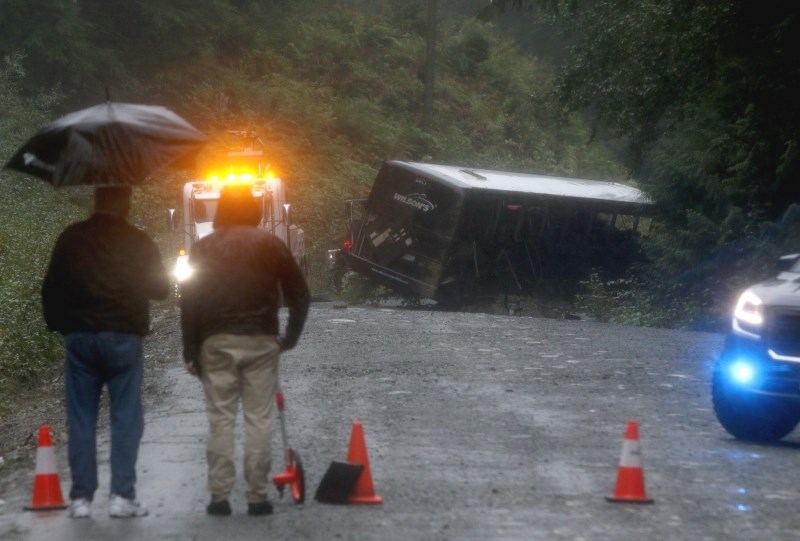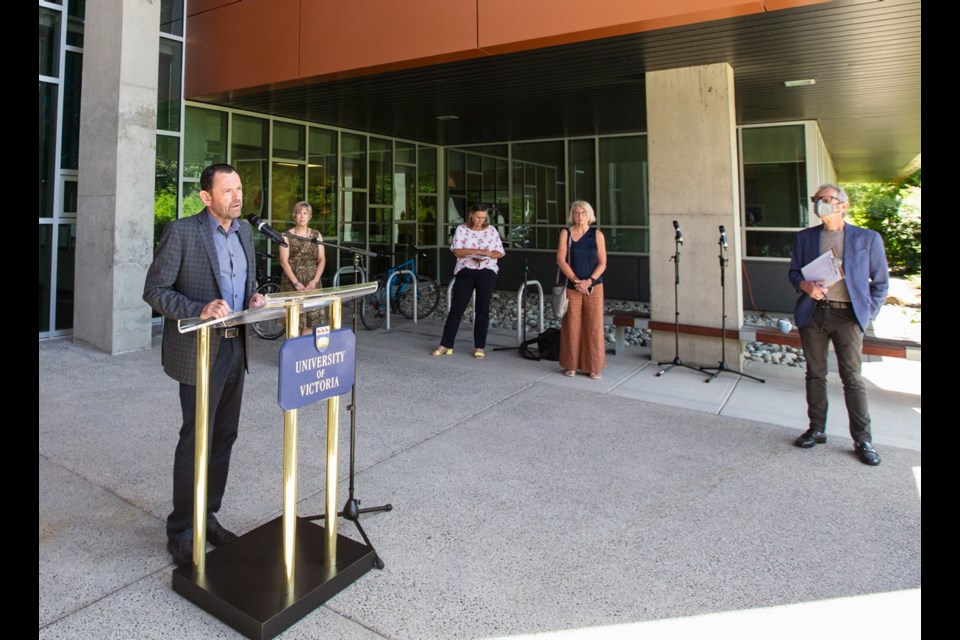Students on field trips will only be transported during daylight, itineraries will be predetermined and wearing of seatbelts will be required in the wake of a bus crash that killed two students in September 2019, the University of Victoria announced Thursday.
The university said a two-way satellite communications device and adequate first aid equipment for the group will also be required for field trips, along with staff on board who can enforce protocols such as adhering to the itinerary and wearing of seatbelts.
A Wilson’s Transportation coach carrying 45 first-year University of Victoria students and two teaching assistants en route to a first-year biology field trip at Bamfield Marine Sciences Centre crashed on Sept. 13 on Bamfield Main, a gravel logging road that links Port Alberni and Bamfield.
Emma MacIntosh Machado, 18, of Winnipeg, and John Geerdes, 18, from Iowa City, Iowa, died in the crash. Many other students were injured.
The university said the bus was mid-way from Port Alberni to Bamfield when it moved to the side of the gravel logging road as a vehicle approached from the opposite direction at a point where the road narrows.
The bus tipped off the side of the road, slid on its side down an incline and onto its roof.
The changes announced by the university come on the heels of an independent report that made 43 recommendations. Ross Cloutier of Kamloops- based Bhudak Consultants Ltd., an expert in outdoor-related risk management, was asked by the university to review policies, pre-trip information and planning processes.
He interviewed students, parents and university employees, visited the crash site, and travelled to Manitoba and Iowa to meet with the families of the students who died.
The report did not assign blame for the crash but cited a number of contributing factors.
They include a late departure from Victoria, road-construction delays, narrowing of the road at the crash site, a soft shoulder from recent road grading, bright car headlights that restricted the bus driver’s vision, an attempt by both vehicles to go through the narrowing point at the same time, lack of enforcement of wearing of seatbelts and inadequate communication devices for travel on Bamfield Main.

“A series of what seem like non-related and low-influence events can combine to form a much larger and catastrophic event,” the report said. “A change in any one of the following influencers may have changed the likelihood, although we will never know for sure.”
The report said staffing for the trip was inadequate. Teaching assistants who could not enforce university policies and procedures and student discipline acted as “group leaders,” rather than senior faculty.
Emergency equipment on the trip “was cursory at best” and the transportation provider did not have a required two-way satellite phone, it said.
UVic president Jamie Cassels, who was in Toronto when he learned of the disaster and said he caught the next flight home “in shock,” said the university will try to implement the recommendations in the next six months to a year.
“The University of Victoria has never experienced an incident of this magnitude and complexity before and we knew there would be lessons for us to learn from the incident with a view to improve our practices,” Cassels said.
“I acknowledge that none of this will erase the terrible loss suffered by the families of Emma and John and the injuries suffered by others, for which I am deeply sorry.”
The safety improvements will apply to every field trip taken by any University of Victoria field school, Cassels said. “What we will take to heart is the lesson that we need better planning and to develop trip-appropriate plans depending on the nature of the subsequent field trip.”
The university, along with the Huu-ay-aht First Nations and the Bamfield Marine Sciences Centre, also plans to advocate for road improvements, something parents of the students have identified as an important priority, said the university. Student Sarah Hunter, who survived the bus crash, started a petition after the crash for road improvements.
The university said it will work with the marine sciences centre, which is co-owned by five western Canadian universities, to explore ideas that would benefit users of the road, such as a pilot-car service, an information hub for travellers with road and other information, and the use of VHF radio for vehicle-to-vehicle communications.
“One of the things that I have heard from many of the families is the importance to them of safety improvements on the Bamfield road, that that would be an appropriate legacy for them,” Cassels said. “I’ve communicated with all provincial ministries that have a say in that. And indeed have met with them very recently to emphasize the importance of road-safety improvements.”
He said Transport Canada and RCMP are doing their own analyses and will make recommendations to the Ministry of Transportation.
Huu-ay-aht Chief Robert Dennis said a $30-million proposal to chip seal the road is awaiting funding approval from the province — the Huu-ay-aht First Nation is contributing
$5 million to that amount.
The marine centre is not booking school field trips until at least April 2021 due to COVID-19. Cassels said that gives the university time to implement the safety changes.
UVic said it will not use buses for field trips to the centre until the recommendations are in place. The university also said it agrees with the review that using the MV Frances Barkley ferry service from Port Alberni to Bamfield might be useful for some field schools.
Since the crash, there has been one field trip to Bamfield, but students travelled via the Lady Rose ferry.
The review also looked at the university’s response to the crash; it recommended development of an emergency-response procedure for off-campus incidents,.
After the crash, the students were transported to Port Alberni and Duncan for treatment, and most arrived back at UVic the following day.
“Students arrived without shoes or jackets; some were dressed in hospital scrubs; many had lost their packs, computers, and cellphones; many had not slept; most had no toiletry or personal care supplies; and many were in shock and traumatized,” said the report.
Cassels said the university has learned from parents the importance of communicating better with families. “One of my regrets is that the compassion and concern that we felt was not fully evident to them in the way in which we took those steps and the way in which we communicated with the parents, and that’s something we’ve taken to heart.”
Cassels said he has apologized to the families.
“This was a traumatic event for many of [the students] — many of them are still recovering from their injuries, they’re still dealing with the ongoing impacts of the event. And we continue to provide the support that we hope will be helpful to them so they can stay on their educational path.”
Cassels said he’s not aware of any lawsuits filed by the families of the students who died or were injured. Students were given $1,000 each to cover incidentals such as lost cellphones or destroyed clothes and parents were given $2,000 each to cover travel costs to be with their children. Cassels said there are claims through ICBC but he doesn’t know the details of any payouts.
— With files from Katie DeRosa



